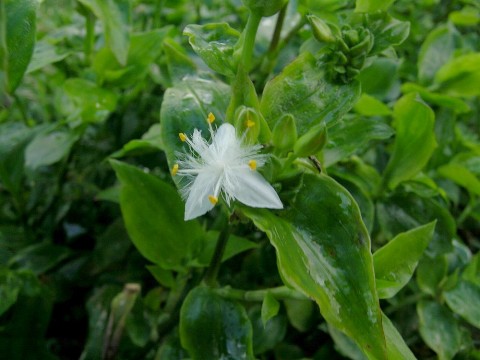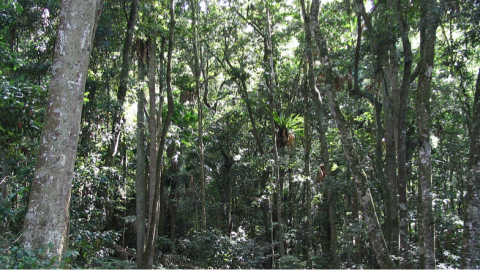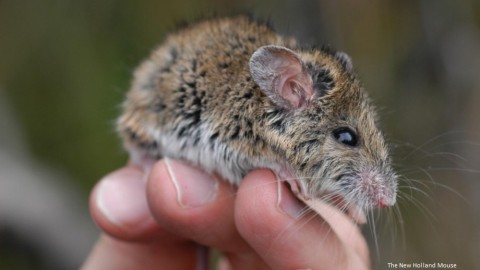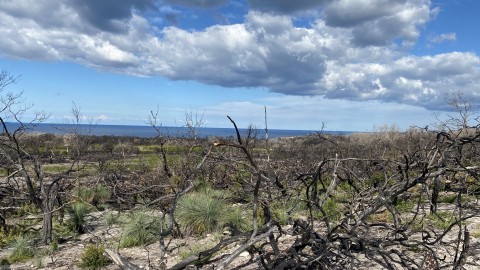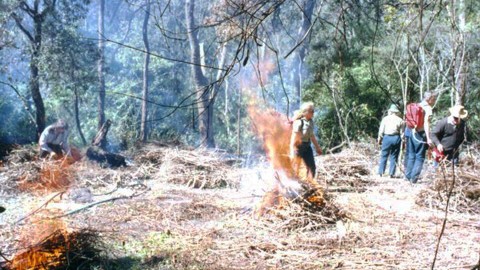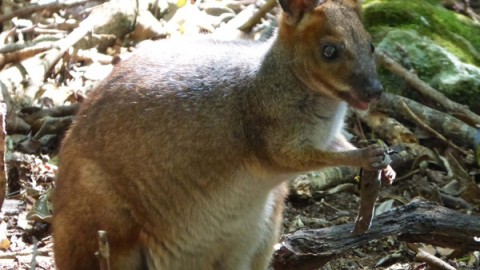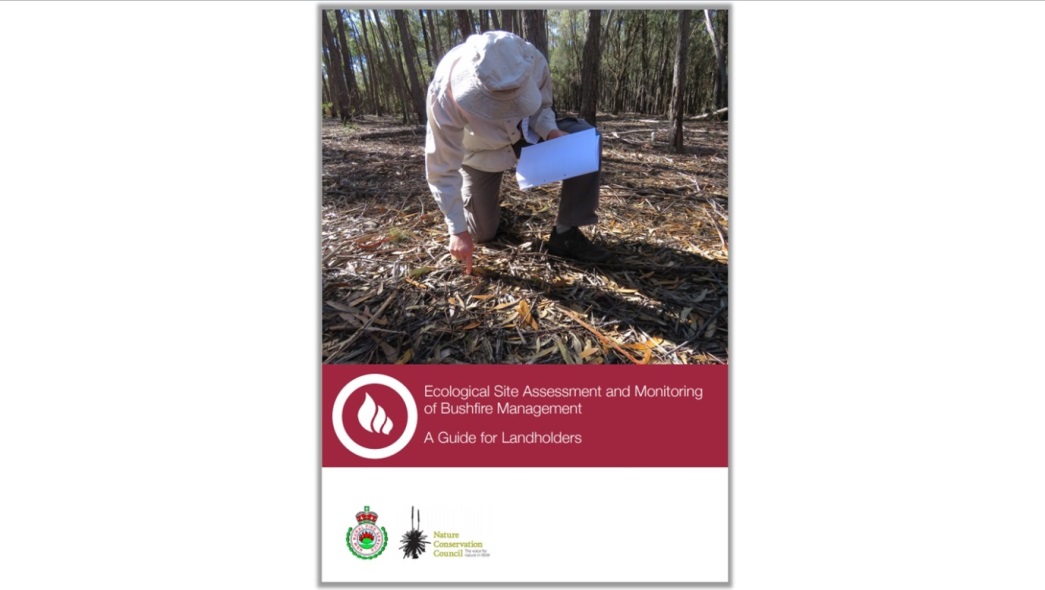Mia Dalby-Ball, from Kingfisher Urban Ecology, was interviewed on the renewed use of an old technology, the flame weeder.
Mia explains the flame weeder has advantages beyond just treating weeds. It may be a used as a tool to provide benefits similar to ecological burning in small patches of urban bushland and around threatened species.
What is flame weeding? What is a flame weeder?
For this discussion flame weeding refers to the use of a hand held device with a small flame. The flame weeder or thermal weeder looks similar to a whipper snipper or brush cutter but it has a small metal cylinder at the end instead of a blade or cord and is connected to a natural gas cylinder. Turn the gas on, light it and a flame of around 20cm by 4-5cm wide comes out the end of the metal cylinder. This device has advantages over steam weeding with greater mobility and manoeuvrability, as it does not need to be attached to a large truck. The small gas cylinder provides ease of use as it is no heavier than a backpack sprayer.
Why did you start using the flame weeder?
The flame weeder was trialled as an alternate method to using herbicides. This is one of a suite of tools that you can use for no-chemical or low-chemical management of bushland areas.
Applying fire through a tool like this also allowed a flame to be applied to quite small patches of bushland on the urban interface where it would have been very difficult to implement a planned burn, thus improving potential for native seed germination. There are often significant challenges in using fire for ecological outcomes. The flame weeder provides some flexibility as it may allow a flame to be introduced into an area considered too small to be burnt or with insufficient fuel loads to support a hot burn. The weather window for using the flame weeder on small patches may also be more flexible than for hazard reduction burns and it may even be used in the rain or near creeks as long as care is taken of wildlife such as frogs.
Has there been success with any particular weed species?
There are different approaches to application for different species and locations and we have gradually been learning about the techniques needed to get an effective outcome.
We have had success with weed species including trad (Tradescantia albiflora sp.), mother of millions (Bryophyllum sp.), farmer’s friend (Bidens sp.) and alligator weed (Alternanthera philoxeroides), as well as some weed grasses and other annual weeds that drop seed. For example in treating trad we rake up the bulk of the trad and then burn the cleared ground to kill off any remaining shoots and stimulate regeneration of the natives. Similarly with annual weeds that drop seed such as farmer’s friend, the bulk of the weed mass can be removed by hand and the ground treated with the flame weeder to destroy the weed seed in the soil. In many instances this approach has reduced the need for follow up. It’s not a cure, as some seed will still come back, but it can start breaking cycles and provide native grasses and other species an opportunity to improve their coverage.
People need to consider that the thermal weeder isn’t appropriate for all weed species and it can take extra time to apply the treatment compared with use of herbicides. Before using the tool you really need advice and training from someone with experience.
What approvals and safety considerations are needed for using the flame weeder?
We have created a safe work method statement for use of the tool including information on managing health and safety risks, environmental risks and fire risks. It is important to consider the quality of the equipment and conduct routine safety checks for its use.
Form an environmental perspective, if you are working in an area with Threatened Species or an Endangered Ecological Community the requirements are similar to those needed for other bush regeneration activities. You would need to have suitably qualified personnel who have an appropriate licence from the Office of Environment & Heritage and have the project listed on the licence. When used correctly the thermal weeder should not create significant smoke.
In terms of burn approvals the current legislation does not specifically address the use of a flame weeding tool. It is important to be in contact with the local NSW Rural Fire Service to discuss your situation and safety requirements. The advice we have received for our particular use is that the activity is similar to conducting a pile burn. During the fire permit season we have been asked to complete the relevant paperwork for undertaking a pile burn and provide notification to the RFS on the day of the burn.
When is it not appropriate to use a flame weeder?
It is not suitable to treat areas with significant amounts of dry grasses, twigs and sticks. This includes patches of kikuyu that may look green on top but there is a risk of fire starting in the dry or dead runners. The thermal weeder will not stop regrowth of weeds with large fleshy tubers such as Balloon vine and is not appropriate for use on some aquatic plants such as Sagittaria.
Where threatened species and fauna are present it is important to have a thorough understanding of the fire response and recommended fire regimes to determine if it is appropriate to go ahead. This may require seeking specialist advice. If using the flame weeder in a creek line it is important to assess the area for the presence of frogs.
We need more research on plant responses to fire to inform this work and in the mean time we can be using this approach to help gather data.
Should flame weeding be applied more than once over the same ground?
This depends on the site, the level of weed impact and also the resilience of natives. The fire response of the weed species is a factor to consider as well as appropriate fire regimes to allow native vegetation to regenerate.
Have you conducted any monitoring and evaluation?
For many Australian plants and ecosystems we don’t have enough detailed data available about appropriate burn intensity, seasonality and frequency. We have fire interval guidelines, but many other questions remain regarding appropriate fire regimes. Interestingly, Mark Ooi’s current research work on seed dormancy and germination is highlighting the importance of timing and seasonality.
The flame weeder has potential to be used to trial a range of treatment approaches for a particular species by burning 2m by 2m quadrants and varying the intensity and season of burning across multiple sites. This information could be particularly useful in managing threatened species where there is limited knowledge of the appropriate fire regime.
In our work we have completed some simple monitoring of quadrants in treatment sites which have shown positive results. More research is required to determine the significance of the results and see if they can be replicated in other sites. With help from student Thomas Taylor we are planning a trial to monitor and compare a range of treatments across multiple sites.
We are calling for any bush regeneration teams who use thermal weeding and have suitable sites to be part of this trial. Sites would need to be around 100m2 in total so we could monitor a range of treatments in 12 quadrants 2m x 2m.
Do you have a site suitable for this trial? Express you interest here and we will pass your details through to Mia and Thomas.
************************************************
Safety considerations for use of a flame weeder may include:
- Training in safe use of the device is essential
- Ensure the equipment is manufactured to Australian Standards
- Ensure there are appropriate approval processes for use through the land manager
- Contact your local RFS for advice regarding fire safety and approvals
- Apply to small patches initially to test the response in the area being treated
- Check for appropriate weather conditions and notifications needed on the day of use
- Ensure water is available to suppress any spread of fire
- Follow safety advice from the equipment manufacturer
- Follow safety protocols for appropriate storage and transport of fuels.
Nature Conservation Council notes that it may be useful to create a set of guidelines for use of the thermal weeder including considerations of suitable and unsuitable environments, appropriate weather and important considerations in preparing and following up.
If you have any comments or further feedback on this topic please contribute these to the discussion forum.
**Please see this response from NSW Rural Fire Service including further information and safety tips

